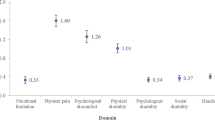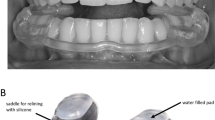Abstract
Aim:
This study examined how well patients accepted and to what extent they were impaired by Invisalign® treatment.
Patients and Methods:
Fifty-four consecutive patients received a questionnaire with 12 questions after 3 to 6 months of Invisalign® treatment. They were given a choice of three responses for each question. Apart from personal data, the questionnaire covered the following parameters: adaptation time, occurrence and duration of pain, possible speech impairment, lingual and mucosal irritations, temporomandibular joint (TMJ) problems and subjective assessment of the success of therapy thus far and the quality of information initially provided.
Results:
78% of those interviewed were females. The highest percentage of patients (44%) were between 20 and 30 years of age. 83% got used to their aligners within one week. 35% had no pain and 54% mild pain while wearing them. This pain usually lasted for 2 to 3 days following insertion of a new aligner. 46% of the patients experienced no speech impairment. 93% felt so secure with their aligners that they felt not at all inhibited about speaking. The majority noticed no narrowing of the lingual space (76%) or irritation of the lingual or buccal mucosa (70%). However, 6% had strong irritations. 44% of the patients had difficulty chewing, mainly because the teeth were sensitive to pressure or had food particles caught between them due to temporary gaps. TMJ problems in terms of clicking were reported by 8% of the patients, although the clicking had existed before therapy initiation. None of the patients had TMJ pain. At the time of the interview, 89% of the patients were satisfied with the progress of therapy. All patients considered themselves well or very well informed about the treatment.
Conclusions:
Invisalign® therapy seems particularly attractive to a clientele comparable to that for the lingual technique. Patients show high acceptance, since they become accustomed to the aligners very quickly and do not suffer much impairment. If indicated, Invisalign® therapy should thus be considered an alternative to the lingual technique for esthetically-demanding patients. This applies especially to patients who cannot be treated by the lingual technique because of the inevitable speech impairment.
Zusammenfassung
Ziel:
Es sollte überprüft werden, wie Invisalign®-Patienten diese Behandlungsmethode akzeptieren und wie sie dadurch beeinträchtigt werden.
Patienten und Methoden:
54 fortlaufende Patienten erhielten nach ungefähr 3 bis 6 Monaten Invisalign®-Behandlung einen Fragebogen mit 12 Fragen. Für die vorgegebenen Antwortmöglichkeiten gab es jeweils drei Abstufungen, von denen eine auszuwählen war. Der Fragebogen enthielt neben einigen persönlichen Daten Fragen zu folgenden Parametern: Gewöhnungszeit, Auftreten und Dauer von Schmerzen, eventuelle Sprechbehinderungen, Zungen- und Schleimhautirritationen, Kiefergelenksprobleme sowie subjektive Beurteilung des bisherigen Behandlungserfolges und der Aufklärung zu Behandlungsbeginn.
Ergebnisse:
78% der Befragten waren weiblichen Geschlechts. Die Altersgruppe zwischen 20 und 30 Jahren war mit 44% am häufigsten vertreten. 83% der Patienten gewöhnten sich innerhalb einer Woche an ihre Aligner. 35% hatten keine und 54% leichte Schmerzen beim Tragen ihrer Aligner. Diese Schmerzen hielten meist 2 bis 3 Tage nach dem Einsetzen eines neuen Aligners an. 46% der Patienten empfanden keine Beeinträchtigung des Sprechvermögens. 93% der Patienten fühlten sich mit ihren Alignern so sicher, dass sie keinerlei Hemmungen beim Sprechen hatten. Die Mehrheit der Patienten spürte weder eine Zungenraumeinengung (76%) noch Zungen- oder Wangenschleimhautirritationen (70%). Bei 6% traten dagegen starke Irritationen auf. 44% der Patienten hatten Probleme beim Kauen, die vor allem darin bestanden, dass die Zähne druckempfindlich waren oder Nahrungsreste durch temporäre Lücken zwischen den Zähnen verblieben. Kiefergelenksprobleme im Sinne von Knacken wurden von 8% der Behandelten angegeben, wobei das Knacken schon vor Therapiebeginn bestanden hatte. Kiefergelenksschmerzen waren bei keinem der Patienten aufgetreten. Zum Zeitpunkt der Befragung waren 89% der Patienten mit dem Behandlungsfortschritt zufrieden. Alle fühlten sich gut bis sehr gut über die Behandlung aufgeklärt.
Schlussfolgerungen:
Die Invisalign®-Therapie scheint eine charakteristische Patientengruppe besonders anzusprechen, die ähnlich der Klientel bei der Lingualtechnik ist. Die Akzeptanz der Patienten ist groß, da die Gewöhnungszeit an die Aligner kurz und mögliche Beeinträchtigungen gering waren. Bei entsprechender Indikation sollte die Invisalign®-Therapie daher als Alternative zur Lingualtechnik für ästhetisch anspruchsvolle Patienten bedacht werden. Dies gilt vor allem für Patienten, die auf Grund der unvermeidbaren Sprechbeeinträchtigung nicht mit Lingualtechnik behandelt werden können.
Similar content being viewed by others
Author information
Authors and Affiliations
Corresponding author
Rights and permissions
About this article
Cite this article
Nedwed, V., Miethke, RR. Motivation, Acceptance and Problems of Invisalign® Patients. J Orofac Orthop 66, 162–173 (2005). https://doi.org/10.1007/s00056-005-0429-0
Received:
Accepted:
Issue Date:
DOI: https://doi.org/10.1007/s00056-005-0429-0




